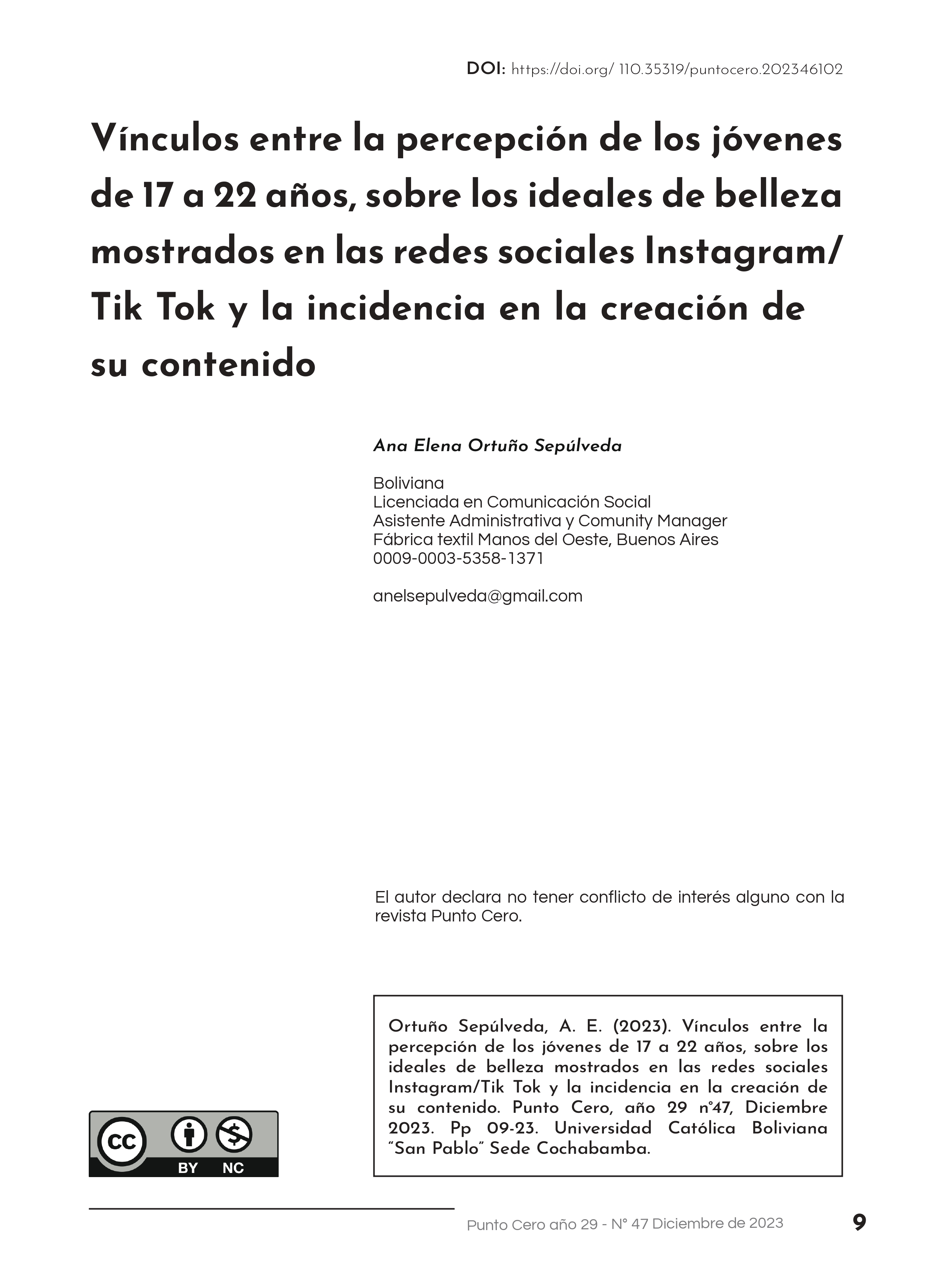Links between the perception of young people aged 17 to 22, on the beauty ideals shown on the social networks instagram/tik tok and the impact on the creation of their content
DOI:
https://doi.org/10.35319/puntocero.202347102Keywords:
Consumption, social networks , filters , stereotypes , young peopleAbstract
The research arises from observing the social networks Instagram/Tik Tok and how a large amount of content is based specifically on the physique, showing hundreds of characteristics of beauty ideals. These were imposed on society for years, currently it is believed that they have changed or disappeared. In this way, the general objective is set which is : to establish the links between the perception of young people between 17 and 22 years old, on the ideals of beauty shown in the chosen networks and its impact on the construction of content within them. Following a mixed methodology, surveys, interviews and content analysis are carried out. This research finds that young people consume ideals of beauty, within the studied applications, they normalize and adapt the content they produce, and they also perceive these stereotypes as their own, when in reality they have been in society for centuries.
References
Aranda, D., Sánchez Navarro, J., Tabernero, C., & Tubella, I. (2010). Los jóvenes del siglo XXI: prácticas comunicativas y consumo cultural. Congreso Internacional AE-IC Málaga 2010 «Comunicación y desarrollo en la era digital», 20.
De La Hera, a. (2021, septiembre 23). Historia de Tik Tok: Nacimiento y evolución de la red social a la que todos quieren imitar. Marketing 4 Ecommerce - Tu revista de marketing online para e-commerce. https://marketing4ecommerce.net/historia-de-tiktok-que-es/
Durán, M., & Cabecinhas, R. (2014). Actitudes y estereotipos sociales en la comunicación. Aspectos psicosociales de la comunicación, 2014, ISBN 978-84-368-3133-7, págs. 43-54, 43-54. https://dialnet.unirioja.es/servlet/articulo?codigo=7847896
Durán, R., Gómez, A., & Sánchez, M. E. (2017). Guía didáctica para la elaboración de trabajos académicos.
Fernández, R. (2020). Instagram: Número de usuarios mensuales mundiales 2018-2023. Statista. https://es.statista.com/estadisticas/1038171/numero-de-usuarios-activos-mensuales-deinstagram-en-el-mundo/
Fernández, R. (2022, mayo 4). Redes sociales con más usuarios del mundo. Statista. https://es.statista.com/estadisticas/600712/ranking-mundial-de-redes-sociales-por-numero-deusuarios/
Gómez-Aguilar, M., Roses-Campos, S., & Farias-Batlle, P. (2012). The Academic Use of Social Networks among University Students. Comunicar, 19(38), 131-138. https://doi.org/10.3916/C38-2012-03-04 DOI: https://doi.org/10.3916/C38-2012-03-04
Guardia, M. (2017). La investigación de procesos interactivos (2°).
Hernández Sampieri, R., Fernández Collado, C., & Baptista Lucio, P. (2014). Metodología de la investigación. McGraw Hill Interamericana.
Hinestroza Köppel, S., & Navarro Posada, D. (2013). Diseño sobre el cuerpo: Estudio de caso sobre las tipologías del cuerpo femenino, aplicado en la ropa interior [DoctoralThesis]. https://repository.upb.edu.co/handle/20.500.11912/785
Lezama Reyes, C. A. (2022). Impacto de las redes sociales en los trastornos de alimentación. http://www.alanrevista.org/ediciones/2015/suplemento-1/art-216/
Lippmann, W. (1997). Public opinion. Transaction Publishers.
Maella, I. (2020). Sobreexposición de menores en redes sociales: Youtube, Instagram y Tik Tok como plataformas de riesgo. - Repositorio Institucional de Documentos [Facultad de Filosofía y Letras / Periodismo, Universidad Zaragoza.]. https://zaguan.unizar.es/record/97735#
Méndez, A. I. (2007). Metodologías y técnicas de investigación aplicadas a la comunicación.114.
Peralta Fernanda. (2015). Ideología dominante. Academia.edu. https://www.academia.edu/23261156/Ideologia_dominante
Piñuel Raigada, J. L. (2002). Epistemología, metodología y técnicas del análisis de contenido. Departamento de Sociología IV Facultad de CC. de la Información Universidad Complutense de Madrid Ciudad Universitaria, s/n. DOI: https://doi.org/10.1558/sols.v3i1.1
Quispe Villanueva, S. L. Q. (2015). Percepciones sobre estereotipos de belleza corporal de jóvenes migrantes de segunda generación que asisten a gimnasios de la 1 ciudad de el alto – distrito. 145. 145.
Salinas Ressini, D. F. (2011). Los medios de comunicación, los ideales de belleza y la manifestación de anorexia. Punto Cero, 16(23), 18-24.
Smith, K. (2019, enero 20). 50 Incredible Instagram Statistics You Need to Know. Brandwatch. https://www.brandwatch.com/blog/instagram-stats/
Torres, A. (2018). El ideal de belleza femenino en Instagram: Una reflexión personal desde la ilustración. https://riunet.upv.es/handle/10251/110150
Umberto Eco. (2010). Historia de la belleza. https://tallerdelaspalabrasblog.files.wordpress.com/2016/04/eco-umberto-historia-de-la-belleza.pdf

Downloads
Published
How to Cite
Issue
Section
License
Copyright (c) 2023 Revista Punto Cero

This work is licensed under a Creative Commons Attribution-NonCommercial 4.0 International License.








